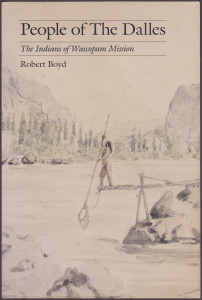
People of The Dalles: The Indians of Wascopam Mission
by Robert T. Boyd (Author)
People of The Dalles is the story of the Chinookan (Wasco-Wishram) and Sahaptin peoples of The Dalles area of the Columbia River, who encountered the Lewis & Clark expedition in 1805–6. The early history and culture of these communities is reconstructed from the accounts of explorers, travelers, and the early writings of the Methodist missionaries at Wascopam, in particular the papers of Reverend Henry K. W. Perkins. Boyd covers early nineteenth century cultural geography, subsistence, economy, social structure, life-cycle rituals, and religion. People of The Dalles also details the changes that occurred to these people’s traditional life-ways, including their relationship with Methodism following the devastating epidemics of the early 1830s. Today, descendants of the Chinookan and Sahaptin peoples are enrolled in the Confederated Tribes of Warm Springs and the Yakama Nation.
BOOK REVIEWS
A Choice outstanding academic book for 1996 (Raymond Bucko, Creighton University) “rich…compelling…highly recommended…All levels” “a rich analysis of the history and culture of the Chinookan and Sahaptin peoples [of] The Dalles [salmon fishery] on the Columbia River…at the time of European contact…. Using the primary source writings of Methodist missionaries active in the area from 1838 to 1844…Boyd examines the effects of radical demographic, economic, political, and religious change. He brings to light new data on these peoples, their relationship with Methodism, and its effect on their own cosmology….This highly recommended work is a fine example of ethnographic an d historic investigation, providing a compelling methodological lesson for students of historical ethnography, anthropology, Native American studies and the Columbia River Plateau. All levels.”
Ethnohistory, fall 1997 (Wayne Suttles, Portland State University) “a major contribution to Plateau ethnography and culture history” “Until now, our sources on the people of The Dalles have been explorers’ and fur traders’ accounts from the early 19th century and ethnographic work from the early 20th century, long after the people had been removed to the Yakama and Warm springs reservations….The writings of [Methodist missionaries] Henry Perkins and Daniel Lee…hitherto unused for their rich ethnographic content, are Boyd’s principal source…[and]bridge a temporal gap in our knowledge of this important site….Descriptions of life-cycle ceremonies are especially full, showing the continuity of present practices at Yakama and Warm Springs. But descriptions of the winter ceremonies show something very different from the present religions, which are based on the teaching of later prophets; in Perkins’s time demonstrations of power included body gashing and dog eating as on the Northwest Coast. Descriptions of the vision quest and camp-meeting conversions suggest an affinity between native practice and Methodism, and hint at what was to come. Boyd knows the issues well and is sympathetic but critical in his treatment of his sources.”
Journal of American History, December 1997 (Michael Harkin, University of Wyoming) “a significant work of scholarship” “a meticulous reconstruction of…local people undergoing traumatic change…The Dalles…was an important meeting place for groups from the Northwest Coast [and] the Plateau…a vibrant borderland in which ideas and goods were exchanged. This unique situation forces the author to focus not on a single “tribe,” but on a network of regional village and ethnic groups….the waves of pandemic diseases and the missionary ideologies that followed closely on their heels were unprecedented…[although] the massive loss of life prepared the way for acceptance of Christianity…Boyd emphasizes the similarities of Methodism to individual spiritual transformations…[and] we see an active synthesis of Christian and Indian beliefs and practices.”
Journal of the Royal Anthropological Institute (Man), June 1999 (William Swagerty, University of the Pacific) “Used in tandem with the Northwest Coast [and]…Plateau…volumes of the Smithsonian Institution’s Handbook of North American Indians, researchers now have reliable scholarly discussions of nineteenth-century themes for this important trade centre and transition zone between culture areas.” “With impressive documentation centring on all of the know diaries of the Oregon Mission, supplemented with independent views from Hudson’s Bay company officers, American traders, soldiers and travelers, Boyd weaves classic ethnography on an ethnohistorical framework to address cultural change….Boyd’s rich ethnography covers subsistence, social structure, religion, and is especially analytical on cultural change….induced by epidemics, the fur trade, missionization and eventual colonial domination.,..during the window between…the 1780s and…1850s.”
Oregon Historical Quarterly, summer 1997 (Laura Peers, Oxford University) “wonderful…Robert Boyd has made a significant contribution to the literature on the people of the Columbia river—and written an extremely interesting book.” “The sections on changes in material culture and on the introduction of Christian elements to the Plateau are especially rich, and constitute wonderful additions to the elements of a traditional ethnography. The appendices consist of documents by Wascopam missionaries…important primary sources for the region published here for the first time.”
Pacific Northwest Quarterly, fall 1997 (Robert Keller, Western Washington University) “Robert Boyd has taken Perkins’s papers, including newly discovered and unpublished ones, combined this rich source with a sturdy collection of ethnographic material, and produced a detailed reconstruction of Indian life on the Columbia at the beginning of permanent American settlement.” “His book combines the fields of western history, church history, ethnohistory, and anthropology….Boyd deserves congratulations for hard labor, diligent research, and careful thinking. Henry Perkins, a generous spirit, would say thank you.”
“Readers will get a living, breathing sense of the religion, economy, and other aspects of the early 19th century culture.”—Annie Charnley Eveland, Walla Walla Union Bulletin
Article on Wascopam Mission by Robert T. Boyd
BOOK DETAILS FOR “PEOPLE OF THE DALLES”
• Series: Studies in the Anthropology of North America
• Publisher: University of Nebraska Press (November 1, 2004)
• Paperback: 414 pages
• Language: English
• ISBN-10: 0803262329
• ISBN-13: 978-0803262324
To Order: